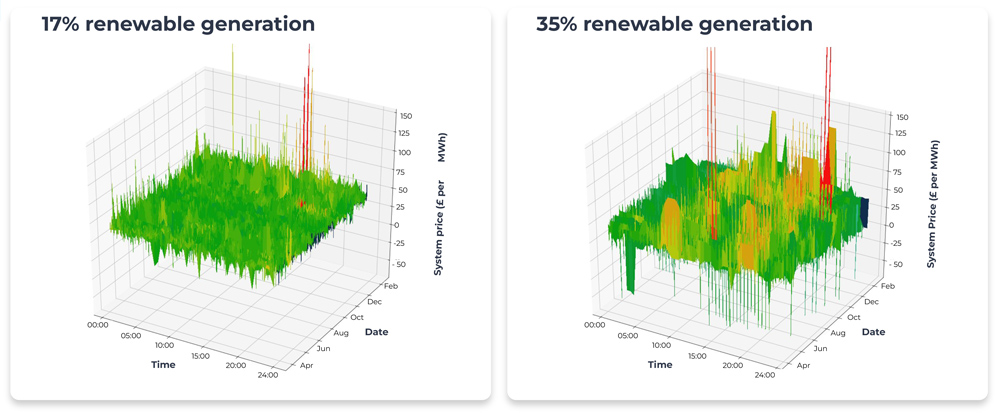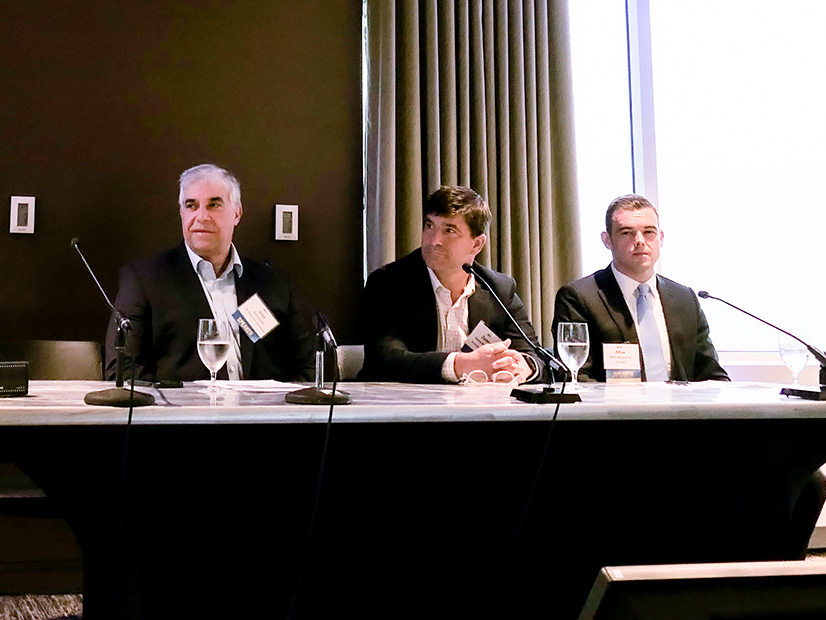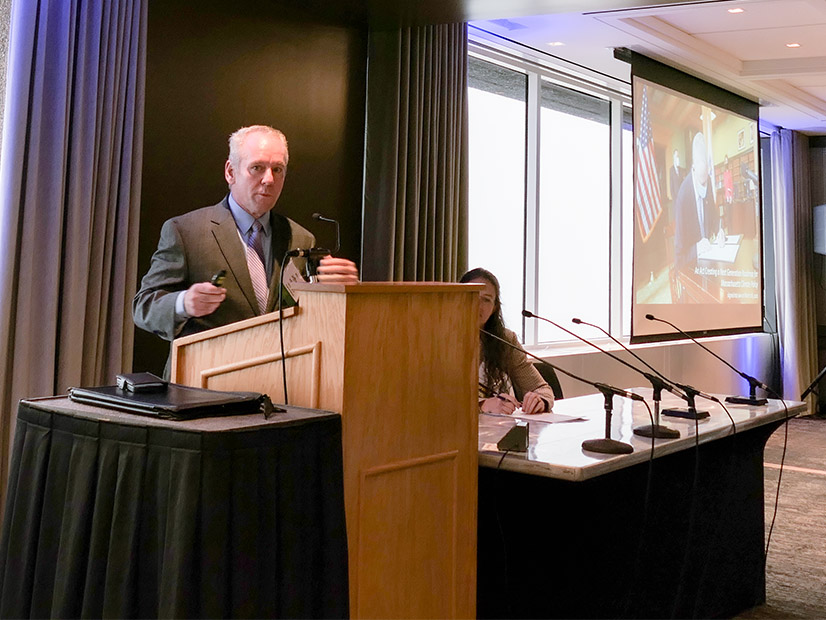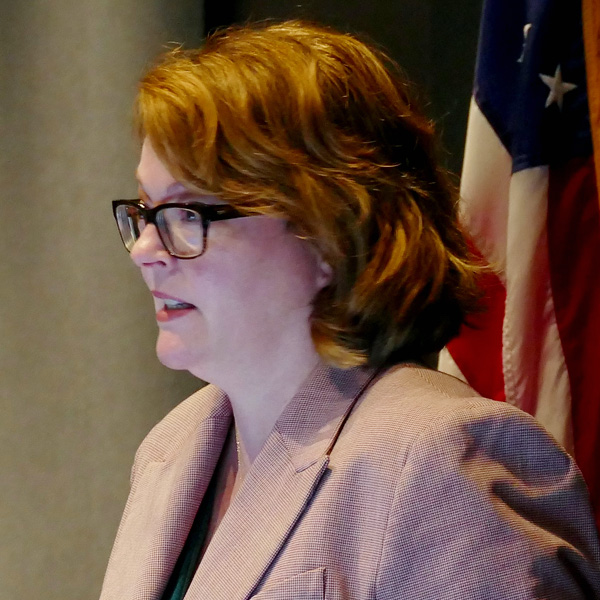Stakeholders Approve Generation Deactivation Issue Charge
VALLEY FORGE, Pa. — The Markets and Reliability Committee voted Wednesday to approved a joint PJM and Independent Market Monitor issue charge to create a new senior task force charged with exploring changes to the timeline in which generators must notify PJM of their intent to retire a resource and how compensation is determined under reliability-must-run (RMR) contracts.
The issue charge passed with 67% support over a competing issue charge proposed by Vistra, which would have tackled the same core topics, but with additional language intended to make the in and out of scope components more explicit. Vistra’s Erik Heinle said the company’s language was built off the PJM/IMM proposal and also would have sought to ensure minimal disruption to the markets when an RMR is implemented, provided better balance by taking the need for operator flexibility into account, added education items — including around the reliability backstop — and tightened the focus of when an RMR contract should be considered.
Presenting the problem statement and issue charge, PJM’s Chris Pilong said there is a concern the increasing pace of generation retirements expected over the next decade will increase the need for RMR contracts. He said the process of reaching an agreement with generators is not standardized and takes considerable time, prompting a desire to get more lead time from resources ahead of their desired deactivation date and to streamline the process.
The committee deferred voting on the proposal during its August meeting as stakeholders continued fine-tuning the scope. (See “Stakeholders Defer Vote on Generation Deactivation Issue Charge,” PJM MRC Briefs: Aug. 24, 2023.)
While Pilong said PJM didn’t have any deal-breaking objections to Vistra’s language, he felt the core of what Vistra was seeking already had been captured in PJM’s issue charge and the additional language around the scope of the discussion was unnecessary and raised procedural issues around how detailed issue charges should be.
Both the PJM/IMM and Vistra issue charges originally would have precluded any solutions that included changes to market rules. However, several stakeholders argued the existing rules do not adequately define how resources operating under an RMR contract fit into the energy and capacity resource stacks and interact with the clearing price. The revised issue charges drafted during the meeting were both modified to include the supply stack and clearing price as being in scope. The Vistra proposal also saw added language about minimizing impacts to consumers added during the meeting.
Pilong said PJM’s intention was that interactions with the supply stack and clearing price would be an educational item and if stakeholders determined that market changes are necessary, that could be referred to another stakeholder group.
Constellation’s Adrien Ford said she believed the resource stack would be considered in scope and having it be to the contrary would cause her to second-guess her support for the issue charge. She said the use of RMR contracts are an indicator of market failures and she would not be comfortable with altering RMR rules without considering changes to rules to address the impact of a potential RMR on the market.
Independent Market Monitor Joseph Bowring said he was happy to see stakeholders interested in addressing how RMR resources fit into the supply stack but cautioned against making the issue charge too broad.
“You can’t solve every problem in every issue charge,” he said. “… Let’s start a parallel one and get started on it immediately.”
Following stakeholder feedback during the first read of the issue charge, the PJM/IMM issue charge was revised to remove a third in scope focus for the new task force to address additional triggers for a retiring resource to qualify for an RMR contract beyond transmission constraints, with the given example of preserving ample supply of black start resources in a region.
Consumer advocates said the scope of the discussion should be balanced with the need to move quickly to shore up issues with the RMR process before an uptick in retirements manifests.
Susan Bruce, representing the PJM Industrial Customer Coalition (ICC), said it makes sense that if the compensation for RMR resources is open for discussion, the impact on the energy and capacity markets also should be part of the solutions on the table.
“Customers that are having to pay for an RMR want to make sure they’re getting the benefit they’re paying for. So I want to make sure we’re not foreclosing on options available in the future,” she said.
PJM Issue Charge on Reserve Certainty Approved
Stakeholders approved an expansive issue charge that aims to rework several areas of PJM’s reserve markets. The PJM proposal received 59% support over a second issue charge proposed by the Market Monitor, which would have focused the scope solely on addressing the decline in synchronized reserves response rate since a market overhaul was implemented in October 2022. (See “PJM Provides First Read on Reserve Certainty Issue Charge,” PJM MRC Briefs: Aug. 24, 2023.)
The document lays out a phased process for addressing six core issues over 12 to 18 months under a new senior task force. Resource performance and penalties, aligning the offer structure with fuel procurement and reserve deployment would begin immediately with the goal of completing in six to nine months. The task force would work concurrently on procuring a quantity of reserves that reflects system needs, with the goal of arriving at a solution in nine to 18 months.
Once the most immediate needs have been addressed, the remainder of the timeline has the task force moving on to the reserve product participation requirements and incentivizing resource flexibility.
PJM’s Donnie Bielak said the issue charge was revised since its first read to add education, particularly around how technology could be used to improve existing practices.
Brock Ondayko of AEP Energy questioned if there’s an opportunity to discuss PJM’s practice of holding resources to a 10-minute response time expectation, rather than the 15-minute mandate under NERC’s Disturbance Control Standard (DCS). Bielak said PJM would consider that a change to PJM’s compliance with reliability standards and therefore out of scope.
Bruce said the scope of the issue charge could cause it to overlap with ongoing work in other stakeholder groups and she questioned whether there is potential for a “feedback loop” where multiple groups take actions to increase reserve response or procurement and overcorrect.
PJM’s Becky Carroll said staff have worked with the Electric Gas Coordination Senior Task Force (EGCSTF) when shaping the issue charge and which components should fall under that group and the new task force.
Deputy Market Monitor Catherine Tyler said the PJM issue charge seeks to roll three different issues under the umbrella of a single issue charge: the synchronized reserve response rate, market issues highlighted during the December 2022 winter storm and maintaining adequacy reserves throughout the clean energy transition. She argued that the EGCSTF already is at work on issues related to Winter Storm Elliott and topics related to the transition and renewable resources would fall best under a separate issue charge.
By having all the issues PJM seeks to address under one issue charge, she said it’s likely any solution would focus on increasing reserve procurement at the expense of other possibilities, including changes to dispatch, market timing and unit commitment.
Ford said the Monitor’s language wouldn’t include discussion of compensation, which she believes needs to be addressed as part of a solution.
Gregory Poulos, executive director of the Consumer Advocates of the PJM States, said state advocates preferred the Market Monitor’s proposal for being more narrowly focused on response rates, which he said is a clearly documented issue, whereas the other topics in PJM’s proposal have more moving parts and interactions with issues before FERC.
Jurisdictional Questions Raised Around Co-located Load Proposal
Stakeholders discussed a proposal that would create new rules for wholesale generators with co-located loads without supply from the system. The package, which was sponsored by Exelon in the Market Implementation Committee, was the only one of several proposals to pass, receiving 51% of the vote in August. (See “Stakeholders Endorse Proposal on Co-located Load,” PJM MIC Briefs: Aug. 9, 2023.)
Generators would be permitted to retain their capacity interconnection rights (CIRs) equal the amount of energy supplied to co-located loads under the proposal and would be treated as a load serving entity (LSE) responsible for service charges and retail delivery costs. Current PJM rules require that generators relinquish a portion of their CIRs equal to co-located load they are serving under these configurations.
Several amendments were offered to the proposal, which largely were opposed by Constellation, with the exception of removing outdated language around cost-based offers. The amendments would remove the requirement that the load be capable of curtailing within 10 minutes on the basis that treating the generator as an LSE means the configuration would have its own metering and would be part of PJM’s load forecast. Any member can block amendments to the MRC’s main motion.
Exelon’s Sharon Midgley suggested the amendments could be considered as an alternate package.
Ford urged the committee to vote against the proposal, saying it would violate the Federal Powers Act (FPA) by treating load that isn’t receiving power from the PJM grid as being FERC jurisdictional. Constellation, joined by Brookfield Renewable, was one of several companies to offer proposals during the Market Implementation Committee’s discussion of the subject.
“It’s in the title. This is a not grid-connected package,” she said.
Midgley said the Exelon-sponsored and MIC-endorsed proposal considers the co-located load as end use and retail load, in line with Constellation’s definition. The MIC-endorsed proposal also allows the generator to offer the entirety of its resource into the PJM capacity market, which accommodates one of the key interests as expressed by Constellation and Brookfield.
Economist Roy Shanker said he believes the proposal would run into jurisdictional issues at FERC and it could set a bad precedent of states ceding jurisdiction over retail loads.
“This sets the stage for a real legal mess. The load being discussed here simply is not FERC jurisdictional load,” he said.
First Read of 2023 RRS Values
PJM’s Andrew Gledhill gave a first read of its recommended values for the 2023 Reserve Requirement Study (RRS), which calls for an uptick in its capacity procurement targets.
The installed reserve margin (IRM), which sets the targeted capacity level above expected loads, would rise from 14.7% for the 2026/27 delivery year (DY) in the 2022 study to 17.6% for the 2027/28 DY. The forecast pool requirement (FPR), which considers forced outage rates, also would increase from 9.18% to 11.65% for the corresponding DYs. (See PJM Presents Preliminary 2023 Reserve Requirement Study to Stakeholders.)
The study continues to base its results on the PRISM software PJM long has used to conduct its reliability modeling, rather than using the hourly model developed from its Effective Load Carrying Capability (ELCC) accreditation studies. PJM ran both sets of modeling for this year’s study and plans to phase over to just using the hourly approach in future studies. The hourly results would have resulted in higher IRM and FPR values.
Gledhill said this year’s study used a more granular hourly approach for its load modeling, separate from the ELCC model, which yielded a more comprehensive look at load uncertainty. Based on that data, PJM believes it has been under-forecasting summer load uncertainty.
James Wilson, a consultant for several state consumer advocates, said he has not heard concerns expressed about summer resource adequacy and questioned why PJM proposes to raise summer requirements by over 3 GW of additional capacity. He encouraged stakeholders to vote against the RRS values.
In addition to setting an initial IRM and FPR value for the 2027/28 DY, the study resets the figures for the previous three years. The preliminary results would be increased by a similar margin for each of those years.
Minimal coincidence between the PJM peak load period and the “world” peak — which is defined as MISO, NYISO, TVA and VACAR — led to the capacity benefit of ties (CBOT) value more than doubling to 2.2% from the 1% value in the 2022 study. To reduce volatility, PJM elected to average the CBOT values from 2017-22 and use that figure, which landed at 1.5%, instead.
Fifth CONE Area Under Consideration
Stakeholders discussed a proposal to create a fifth cost of new entry (CONE) area for the Commonwealth Edison (ComEd) region in Illinois. The gross CONE in the new area would be $201,714/MW-year, while CONE Area 3, which ComEd is currently under, is $197,800/MW-year. (See “Competing Proposals Addressing Local Factors on Net CONE Merged,” PJM MIC Briefs: Sept 6, 2023.)
The change is the result of a process exploring how to account for local or state factors that could impact cost to build the reference resource in a specific region. PJM’s Gary Helm said the primary reason for calculating a separate CONE value for resources in the ComEd region is the requirement that generators be emissions free by 2045 under the state’s Climate and Equitable Jobs Act (CEJA).
“There is debate over whether that can or cannot be achieved, but in this case for all intents and purposes we would reflect that all natural gas resources, which is the reference resource, would have a reduced asset life,” Helm said.
The proposal would calculate a new CONE value for the new area by effectively applying an asset life factor with the assumption that the reference resource, currently a combined cycle resource, would retire in 2045. All other variables would stay the same at this time but could be changed during the next quadrennial review.
J-Power USA introduced a package to implement an automated process for the creation of new CONE areas in the future. That proposal was dropped when it concurred with PJM that the existing stakeholder process is sufficient.
Clara Summers of the Illinois Citizens Utility Board (CUB) said the proposal is very specific to Illinois and could set a precedent that other state consumer advocates should note.
Proposed Changes to Load Forecast Adjustment Timeline Discussed
The MRC reviewed proposed revisions to Manual 19 that would change the data PJM requests when electric distribution companies (EDCs) or LSEs submit load forecast adjustments. The new language would request hourly data as well as a 15-year forecast with a public document detailing how the forecast was created and move up the Load Analysis Subcommittee’s review of forecast adjustment requests to initiate in September and October. (See “PJM Presents Quick Fix on Load Forecast Guidelines,” PJM PC/TEAC Briefs: Sept. 5, 2023.)
The proposal is focused on providing PJM with more insight into data center load growth. In past MRC meetings, PJM’s Mary Mooney said data centers often can be built faster than other large loads, meaning there’s less time to plan and build needed grid adjustments, and the load often is not captured in the existing forecasting structure that is based on projected labor data.
Mooney said PJM would avoid double-counting load already captured in the forecasting it does based on economic data, but she does not anticipate this to be a major concern as data centers have outsized electric needs compared to their employment figures.
Wilson argued the proposal should require that a load adjustment be in the footprint of the relevant EDC. He also recommended PJM hire an independent consultant to do a study and forecast of long-term data center load, rather than rely on information provided by EDCs.
Members Committee
Nominating Committee
The Members Committee elected a new slate of sector nominees for the 2023-24 Nominating Committee during Wednesday’s meeting. The representatives will be as follows:
-
- Electric Distributors: Bill Pezalla of the Old Dominion Electric Cooperative (ODEC);
- End Use Customers: Susan Bruce of the PJM ICC;
- Generation Owners: Marji Philips of Rolling Hills Generating;
- Other Suppliers: Sean Chang of Shell Energy North America; and
- Transmission Owners: Laura Yovanovich of PPL Utilities.
PJM Revises Code of Conduct to Promote Civil Discourse
PJM General Counsel Chris O’Hara said the code of conduct staff and stakeholders are held to has been updated in the wake of incidents where personnel have been singled out and attacked during meetings. The changes reflect expectations during stakeholder meetings and how PJM will respond to future incidents.
“These personal attacks are completely inappropriate. Personnel presenting on PJM’s behalf have the full backing of the PJM administration,” he said.
PJM has a legal obligation to create a workplace that is free of discrimination for its employees, O’Hara said. The appropriate venue for stakeholders to comment on PJM staff performance is the Liaison Committee.
Members Committee Chair David “Scarp” Scarpignato encouraged stakeholders to maintain a friendly decorum during meetings.




